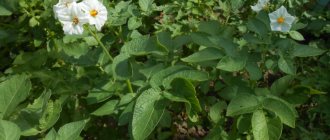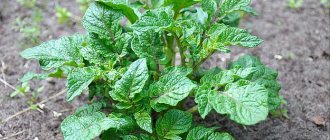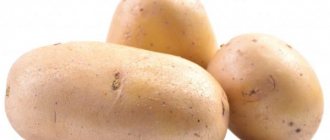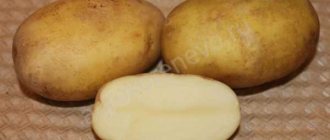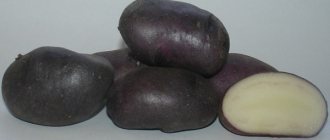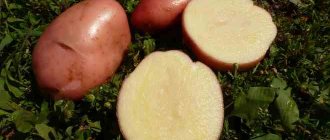Spreading
The Felox subspecies was bred by German breeders. The originator is Saka Palanzenzucht.
In Russia, the distribution of the subspecies is carried out by the Oktyabrsky enterprise and the Sedek farm.
Today the variety has become widespread throughout the world..
It is grown in Germany, Austria, Holland, India, and China. It also actively grows in Belarus, Moldova, Kazakhstan, Ukraine, and the Russian Federation.
In Russia, potato bushes of this variety can be found in almost all regions. The subspecies grows well in any weather conditions. Tolerates drought and sudden temperature changes.
Important! This variety is recommended for early planting and early harvesting.
Potato Felox variety characteristics
| Variety name | Felox |
| general characteristics | high-yielding variety of German selection |
| Maturation period | 60-70 days |
| Starch content | 16-17% |
| Weight of marketable tubers | 100-120 gr |
| Number of tubers in a bush | 19-25 pieces |
| Productivity | 550-600 c/ha |
| Consumer qualities | excellent taste, suitable for preparing any dish |
| Keeping quality | 90% |
| Peel color | yellow |
| Flesh color | light yellow |
| Preferred Growing Regions | Northern, Northwestern, Volga-Vyatka, Middle Volga |
| Disease resistance | resistant to potato canker pathogen, golden cyst nematode, moderately resistant to late blight |
| Features of cultivation | adapts to any type of soil |
| Originator | Saka Palanzenzucht (Germany) |
The bushes are an erect, leafy variety. The leaves are large or medium. They have a dark emerald hue. The edges of the leaves are slightly jagged.
The surface of the leaves is glossy. The corolla is large. It has a burgundy-lilac color. The anthocyanin tint of the bud is very weak. The tuber is elongated and has a rounded shape at the edges.
Weight varies between 100-120 g. The largest specimens weigh 200 grams. The peel has a soft amber hue. The pulp is light, snow-white-amber. The starch content reaches 16-17%.
You can compare tuber weight and starch content with other varieties using the table below:
| Variety name | Starch content (%) | Mass of tubers (g) |
| Artemis | 11-15 | 110-120 |
| Tuscany | 12-14 | 90-125 |
| Openwork | 14-16 | 95-115 |
| Santana | 13-17 | 100-170 |
| Nevsky | 10-12 | 90-130 |
| Ramos | 13-16 | 100-150 |
| Lapot | 13-16 | 100-160 |
| Belmondo | 14-16 | 100-125 |
Important! Experienced gardeners recommend spraying the tubers with copper sulfate before planting. With the help of growth stimulants, the bushes grow more lush, and the formation of tubers occurs at a rapid pace.
Potatoes store well, the main thing is to remember the necessary conditions and terms. We have prepared for you detailed information on storing potatoes in boxes, in winter, in the refrigerator and peeled.
Description and character of the variety's history
Fritella potatoes are included in the category of mid-season, well-stored varieties (keeping quality reaches 95%). Ripening dates occur 80-100 days after germination. Marketability 83-98%.
The variety was bred by farmers from the All-Russia Research Institute. A.G. Lorha with the participation of breeders from the Korenevo Agrocenter. The vegetable has been listed in the State Register since 2016. It is intended for cultivation in the temperate zone and in the northern regions. These are the Central Black Earth and Northwestern regions.
The base varieties for crossing were Effect and Innovator.
Bushes with strong tops, shoots are strong and do not lie down. The position is semi-erect. The foliage is moderate. 6-10 large oval-elongated tubers grow in 1 potato nest. Corollas with a slight anthocyanin tint.
Distinctive features of tubers:
- large size vegetables (maximum weight exceeds 200 g);
- average weight 120-150 g;
- elongated, oblong shape;
- starchiness 15-21%;
- yellowish smooth skin;
- ocelli small, superficially located;
- The pulp is snow-white, with a mealy and dry texture.
The tubers have excellent marketability, taste qualities deserve 4.6-4.7 points. Culinary use of SD. The tubers produce lush puree and aromatic side dishes. The flesh does not darken when boiled or fried; it is tender in all dishes. The variety is suitable for industrial processing, production of chips, starch, and semi-finished products.
Photo
The photo shows the Felox potato variety:
Productivity
Felox is an early ripening variety. From planting to technical ripeness, 65-70 days pass. The harvest ends at the end of August. The productivity of the variety is very high .
250 centners of potatoes are harvested from 1 hectare. The maximum yield is 600 c. One bush forms 19-25 tubers. The fruits are resistant to damage. They keep in cool vegetable stores for about six months.
In the table below you can see what the yield is and how many tubers there are in a bush for other potato varieties:
| Variety name | Productivity (c/ha) | Number of tubers in a bush (pcs) |
| Belmondo | 450-800 | 7-9 |
| Gourmet | 350-400 | 12-14 |
| Palm | up to 450 | 5-9 |
| Blue Danube | 350-400 | 8-12 |
| Lily | up to 670 | 8-15 |
| Tiras | 210-460 | 9-12 |
| Colombo | 220-420 | up to 12 |
| Santa | up to 570 | up to 20 |
They have excellent commercial qualities . Marketability reaches 98%. The variety is in great demand. Sold in markets and stores. Felox potato variety can be transported over long distances .
Growing and care
The first time the area is loosened a week after germination. To prevent the appearance of a crust on the surface, loosening is carried out every time after watering or precipitation. Hill up for the first time to protect against pests and possible frosts (with a tops length of 10 cm). The bushes are sprinkled with earth a second time when they grow to 20 cm.
Potatoes are fed three times:
| Deadlines | What is used |
| 12-14 days after disembarkation | Mullein Urea |
| At the beginning of flowering (3 weeks after the first feeding) | Ash Superphosphate Ohm Giant Potassium sulfate |
| When tubers are actively setting and growing (30-35 days before harvesting) | Speedfol Amino Epin-Extra (for irrigation) Phosphorus-potassium complexes |
Landing
The agricultural technology of this variety is standard. Planting takes place in early May . It is recommended to plant tubers after perennial grasses, peas, beans, corn, and beans. Recommended planting pattern: 30x65 cm. Depth should not exceed 8 cm.
If you plant Felox seed potatoes too deep, they may rot in the ground. Before planting, water the soil thoroughly.
The soil should be slightly acidic. Suitable sandy, loamy, turf soil. But it is best to use black soil.
Before planting, check for any defects or infestations . It is not recommended to plant defective tubers. The optimal weight of planting material should be 60-80 g.
Important! This subspecies grows best in soft, loose soil. In stone soil during the growing season, the growth of bushes can slow down greatly. In this case, the tubers are greatly deformed.
There are many ways to grow potatoes. On our website you can get acquainted with Dutch technologies, as well as methods of growing potatoes in bags, in barrels, under straw.
Diseases and pests
The subspecies is highly resistant to cancer, golden cyst nematode (Ro1,4). Moderately resistant to late blight of tubers and leaves.
Often, nightshade plants, including potatoes, are threatened by diseases such as Alternaria, Fusarium, Verticillium, and scab. Read more about them in the articles on our website.
Subject to attacks by wireworms.
Click beetles are also noted among the pests. They have an elongated body and settle on the stems and leaves of the plant. Causes irreparable damage to agricultural land.
This subspecies of potato requires preventive measures against pests, for example, against the Colorado potato beetle. Read in the articles on our website what folk remedies and chemical preparations exist to combat adults and larvae.
Insecticides are used as prevention. You can use granular products that are applied once. The “Prestige” product is perfect.
Potato Felox is an early ripening variety. Has a table purpose. Can be transported over long distances .
Resistant to mechanical damage. It has excellent commercial qualities. Grows well in any weather conditions. Loves slightly acidic soil, systematic watering, and fertilization. Read about when and how to apply fertilizers and how to do it correctly when planting in the detailed materials on our website. And mulching will help in the fight against weeds.
We invite you to shop with us at the Gardener's Center!
Bellarosa
Early variety, table use. The ripening period from planting to harvest is 60-70 days. Advantage of the variety: resistant to viruses, nematodes, scab, cancer and late blight, very early. High taste, boiled potatoes are crumbly. The tubers are leveled, weighing 110-210 grams, elongated oval in shape. The skin is red with shallow eyes, the flesh is light yellow. When harvesting, it is the Bellarosa potato variety that can surprise you with its yield.
Gala
Delicious mid-early variety. The ripening period for a full-fledged harvest is 70–80 days. The tubers are elongated-oval, with a smooth skin of light yellow shades; the eyes are small and shallow. The average weight of the fruits is 100–120 g, they grow up to 7–8 cm in length and up to 5 cm in width. Up to 25 tubers are obtained from a bush. The pulp is light yellow or yellow. Starch content is minimal: 11–13%. The variety is resistant to golden cyst nematode and root canker, and weakly resistant to late blight. Gives a good harvest in both dry and rainy years. Well kept.
Zhukovsky early
Early ripening. Table use and for processing into crispy potatoes in the autumn. The tubers are pink. The eyes are red. The pulp is white. The eyes are small. The corolla is red-violet. On the 60th day after planting, it produces 10–12 t/ha of marketable tubers, in the final harvest 40–45 t/ha. Marketability is 90–92%. Weight of marketable tuber is 100–120 g. Starch content is 10–12%. Resistant to potato nematode, common scab, rhizoctonia. Moderately susceptible to late blight on tops and tubers. Moderately resistant to bacteriosis. Relatively heat and drought resistant. Value of the variety: early ripening, high marketability of early products, resistance to potato nematode.
Ilyinsky
Medium early, table purpose. Marketable yield is 176-346 c/ha. Maximum yield - 355 c/ha. The tuber is oval. The peel is red, smooth. The pulp is white. The weight of the commercial tuber is 54-158 g. The starch content is 15.7-18.0%. The taste is good. Marketability 87-99%. Keeping quality 93%. Resistant to the pathogen of potato cancer, susceptible to golden potato cyst nematode. The tops are susceptible to the causative agent of late blight; the tubers are moderately resistant. Value of the variety: stable yield, good taste of tubers, high marketability.
Related article: Potato variety “Daisy” - description and photo
cornflower
Mid-early potatoes, which have the romantic name Cornflower, form a bush of medium height, semi-erect, intermediate type. The tops are strong, bright green. The leaves are open, dark green, medium in size. Corolla of reddish-violet small flowers. The anthocyanin color on the inside is weak or medium. The tubers are elongated-oval, uniform in size and shape, covered with a glossy, very beautiful skin with superficial small eyes. The color of the peel is very unusual, blue-violet, the sprouts are deep purple. The pulp is creamy when cut, the consistency is soft, dense, medium watery and mealy. The average weight of a commercial tuber is 77-110 g.
Handsome
Medium early, suitable for processing into French fries and dry mashed potatoes. Marketable yield is 169-201 c/ha. Maximum yield 284 c/ha. The tuber is oval with small eyes. The peel is smooth, red. The pulp is creamy. The weight of the commercial tuber is 91-166 g. The starch content is 12.4-17.8%. The taste is good and excellent. Marketability 85-98%. Keeping quality 97%. Resistant to potato cancer pathogen. Susceptible to golden potato cyst nematode, resistant to tubers and moderately resistant to late blight pathogen on tops, resistant to wrinkled and striped mosaic.
Fritella
Fritella seed potatoes are a mid-season variety, suitable for table use, highly suitable for processing into fries. The tubers are beige, elongated oval in shape. The peel is smooth, the eyes are superficial, the flesh of the tuber is white. The variety is resistant to cancer and susceptible to potato golden cyst nematode. Relatively resistant to late blight on tops and tubers, moderately resistant to common scab, moderately susceptible to viral diseases, rhizoctonia and alternaria. Potential yield 550-480 c/ha, starch content 15.0-21.0%, marketable tuber weight 120-150 g, good taste. Based on the technological and biochemical characteristics of the tubers, the variety is highly suitable for processing into “fries”. The tubers are characterized by high marketability and satisfactory keeping quality during winter storage. Value of the variety: has high resistance to late blight, scab, bacterial rot and many viral infections.
Blue
Mid-season variety (90-100) for table use. The tuber is round, white with small eyes. Mesh peel. The pulp is white. The weight of the commercial tuber is 70-100 g. The starch content is 16.3-18.2%. Marketability 98%. Productivity 582 kg/sot. Resistant to the causative agent of potato cancer, late blight, bacteriosis, and scab. Not resistant to nematodes.
Violet
The tubers of this potato are covered with a dark purple skin, which sometimes reaches almost black color. Beneath it there is pulp of almost the same color (see photo). The oblong tubers reach an average length of about 10 cm and weigh about 70 g. The tubers retain their color even after heat treatment. It is still unknown how exactly this variety appeared. Many believe that its homeland is South America, where it is still grown in large quantities. Purple potatoes, due to their thicker skin, can be stored for quite a long time. These root vegetables have a light nutty flavor.
Red Scarlett
An early variety of Dutch selection, for table use. The ripening period from planting to harvest is 60-70 days. The advantage of the variety: high and stable yield, long shelf life, resistance to various viral diseases, does not get soft when cooked, has a delicate taste. Tubers weighing 56-102 grams, elongated oval in shape. The peel is smooth, red with small eyes, the flesh is pale yellow. Suitable for any culinary processing.
Morning
Mid-season. Table purpose. Potato bushes of this variety are of medium height, leaf type, semi-erect. The flower corollas are very large. The leaves are medium sized, open, light green in color. Root vegetables are oval or round in shape with a light beige skin and very small eyes. The average weight of one tuber does not exceed 130 g. The pulp is light yellow in color and contains starch at the level of 15-18.0%. The taste characteristics and product quality are very good. The marketability of the harvest is 82-97%. Keeping quality is 95%. The total yield is 200-230 c/ha.
Article on the topic: Potato variety “Nikulinsky” - description and photo
Kumach
Mid-early. High-yielding variety. The tubers are red, large, weighing 110-140g, round-oval, small eyes, few in number. The pulp is white, starch content is 14-16%. The variety is distinguished by its resistance to potato canker and scab, good uniformity of tubers, high marketability, and excellent shelf life. The taste is excellent! The peculiarity of the variety is the attractive appearance of the tubers combined with marketability and excellent taste.
Nikulinsky
Medium late, table purpose. The corolla is pale red-blue-violet with white tips on the inside and outside. The tuber is round, white. Mesh peel. The eyes are numerous, uncolored, and small. The flesh is white and does not darken when cut. Marketable yield is 170-294 c/ha. Maximum yield - 410 c/ha. The weight of the commercial tuber is 70-135 g. The starch content is 12.5-21.3%, at the standard level. The taste is good. Marketability 71-95%. Keeping quality 95%. Cancer resistant. It is characterized by average susceptibility to late blight; the tubers are susceptible, weakly affected by viral diseases, and are prone to tubers being affected by common scab and blackleg. Value of the variety: stable yield, good taste and keeping quality of tubers.
